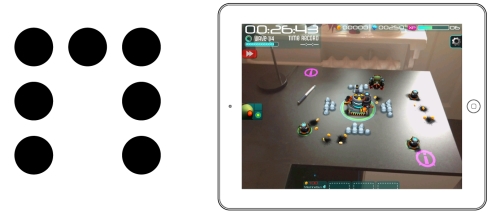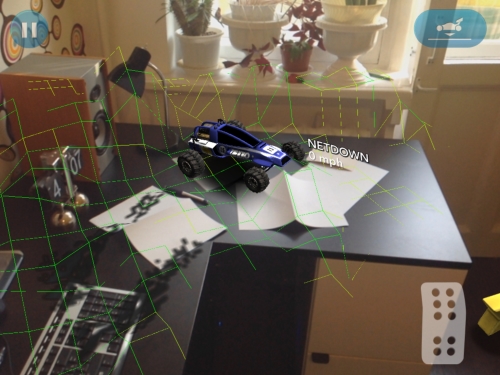The number of AR games on iTunes is not that big; they are still a niche product. This can be considered as a form of advantage, since any new title in this domain gets special attention. It is a good way to make a name for yourself. The term augmented reality sounds so great! The funny thing is that although the technology itself can be very complex, some of the game elements may be much easier to produce than traditional games because they require less graphic assets. Many AR games require fewer assets since only general characters are needed; but game scene decorations will be taken by players from the real world.
One of the famous examples of AR games for iOS is the AR Defender franchise from int13 (http://www.ardefender.com/)—a smart tower-defense game series that looks especially breathtaking when a player uses outdoor environments as their background or when several people are playing in multiplayer mode, sitting at one desk. The game process is very balanced and addictive (it does not look like a plain technological demo application). AR, in most cases, does not cause frustration and works pretty reliably. The product can be easily considered one of the best demonstrations of fiducial-based AR.

The fiducial marker used in AR Defender game series and a screenshot of the game
NASA's Spacecraft 3D (http://www.nasa.gov/connect/apps.html) is not entirely a game, rather it's an educational tool. However, the process includes some gaming experience. The application is free and allows you to control various spacecrafts, including the Martian Rover. Authors of the application have used a very creative approach to designing the marker; it looks like a photo of a grain of sand taken by the Curiosity rover.
I like the idea implemented into ARSoccer (http://labs.laan.com/products/arsoccer/) by Laan Labs. The game tracks the motion of the player's feet and adds a virtual soccer ball, so a juggling game can be played in AR. The concept and realization is so brilliant! There should be more games with such mechanics.
One of the most ambitious initiatives is an intriguing game project called Tabletop Speed by Dekko (http://www.dekko.co/tabletop-racing-out-now-for-ios/). This is a Markerless AR application that tries to develop a 3D landscape of the nearby surroundings using the regular camera included in iOS devices. The standard background for the game is a tabletop that has been made messy with some dispersed magazines, pencils, small boxes, and so on. The application analyzes these objects (apparently some parallax calculations are used) and tries to recreate their 3D geometry in a virtual form. The resulting landscape is used as the track for a race. This sounds very exciting, but the process of 3D map generation may require some patience and attentiveness from the player.

A screenshot from Tabletop Speed by Dekko. The grid system is shown
AR Earth Invasion by Hoi Yan Mak, SKY SIEGE 3D by Simbiotics, and some other titles are examples of the AR fixed shooter, a very popular and viable subgenre. The concept is simple, players get some weapons (the characters are gun-turret operators, fighter pilots, drone operators, and so on), and they need to find and destroy various flying enemies by moving a smartphone or tablet around. Such games do not need any special fiducial markers. They may find some minor reference points around and utilize the advantages of the internal gyroscope. Of course, the space orientation method can be inaccurate, but because of the dynamic nature of such games and because virtual objects on the screen are considered as flying in space and not staying on any fixed surface, this is less evident and can be overlooked by players.
